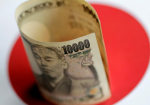One of the most significant market responses to Russia's attack on Ukraine is in the expectations for the trajectory of monetary policy in many of the high-income countries, including the US, eurozone, UK and Canada. The market has abandoned speculation of a 50 bp hike in mid-March by the FOMC and the Bank of England. It has also scaled back the ECB's move to 20 bp this year from 50 bp. Even after the Russian invasion, the market had discounted a 75% chance that the Bank of Canada would hike by 50 bp. But, by the time the BoC met last week, the market had correctly anticipated only a 25 bp hike would be delivered. The US warned on February 11 that Russia could attack Ukraine at any moment. The day before that warning the Fed funds futures strip implied a
Topics:
Marc Chandler considers the following as important: $CNY, 4.) Marc to Market, 4) FX Trends, China, CPI, ECB, Featured, newsletter, trade, US
This could be interesting, too:
Nachrichten Ticker - www.finanzen.ch writes Die Performance der Kryptowährungen in KW 9: Das hat sich bei Bitcoin, Ether & Co. getan
Nachrichten Ticker - www.finanzen.ch writes Wer verbirgt sich hinter der Ethereum-Technologie?
Martin Hartmann writes Eine Analyse nach den Lehren von Milton Friedman
Marc Chandler writes March 2025 Monthly
One of the most significant market responses to Russia's attack on Ukraine is in the expectations for the trajectory of monetary policy in many of the high-income countries, including the US, eurozone, UK and Canada. The market has abandoned speculation of a 50 bp hike in mid-March by the FOMC and the Bank of England. It has also scaled back the ECB's move to 20 bp this year from 50 bp. Even after the Russian invasion, the market had discounted a 75% chance that the Bank of Canada would hike by 50 bp. But, by the time the BoC met last week, the market had correctly anticipated only a 25 bp hike would be delivered.
The US warned on February 11 that Russia could attack Ukraine at any moment. The day before that warning the Fed funds futures strip implied a little more than an 80% chance of a 50 bp hike and about 162.5 bp of tightening this year. Now, the December Fed funds futures has 150 bp of tightening discounted this year. The two-year yield reached a high of almost 1.64% on February 10. Last week, the yield briefly slipped below 1.26%, its lowest level since February 4, but finished a little above 1.50%. The US 10-year yield had traded above the 2% threshold on February 25. It gapped lower last Monday and fell to almost 1.68% on March 1, the lowest since January 24, before rebounding to the 1.90% area. The US 2-10 curve has flattened sharply from this year's peak near 90 bp on January 7 and slipped below 30 bp on March 3.
A similar development has been seen in the UK. On the eve of the US warning, the market had slightly more than a 60% chance that the BOE would hike 50 bp on March 17. The has been considerably unwound. At the end of last week, it had been downgraded to about a 20% chance. The 2-year yield peaked on February 16 just shy of 1.55%. At the low point last week, it slipped below 0.80% but finished the week at about 1.05%. The 10-year Gilt inched above 1.60% the same day the two-year yield peaked. It gapped lower on March 1 and briefly traded below 1.10% before rebounding to finish the week near 1.20%. The UK's 2–10-year curve had flattened from about 35 bp in mid-January to less than five basis points in mid-February. It made a marginal new high (steepness) for the year of almost 40 bp before finishing last week below 15 bp.
The focus shifts to the European Central Bank. It meets on March 10. Broadly speaking, we see Russia's attack on Ukraine and the subsequent response as sharpening both blades of a scissors. Growth will likely be weaker and inflation stronger. Europe is the epicenter, and it complicates the ECB's task. A shift in policy was not on the table for this meeting. The focus is on the new economic forecasts and the adjustment to the forward guidance on its asset purchases.
The forecasts are likely to recognize the contradictory impulses. In December, the ECB's staff forecast 4.2% growth this year, 2.9% next, and 1.6% in 2024. This year's growth prospects are likely to be reduced but pushed into next year and maybe a bit into 2024. ECB's Chief Economist Lane suggested that the rise in oil prices could shave 0.3%-0.4% off growth.
The ECB's inflation forecast was more controversial. It projected 3.2% CPI this year, which seems low, even before the war. Investors learned last week that Eurozone inflation reached 5.6% in February, bolstered by higher energy and food prices. The core rate ticked up to 2.6% from 2.3%. The ECB has forecast inflation falling to 1.8% in 2023 and 2024. This may adjust higher.
Some central bankers, like the governor of Austria's central bank, seem to still be pushing against the sequencing that ECB President Lagarde had outlined. The Pandemic Emergency Purchase Program will end this month and to smooth out the transition the pre-existing QE effort (Asset Purchase Program) would double to 40 bln euro a month in Q2. She had been very clear that the bond buying would end a little before the first hike. So, the forward guidance on the asset purchases will reveal the beginning of the rate hike window.
If the ECB wants to have flexibility to raise rates before the end of the year, it will likely have to modify its guidance. It could do so by signaling that the APP will wind down in Q3. Given the high degree of uncertainty right now, it might choose instead to reaffirm its commitment to the APP purchases in Q2 and indicate Q3 is under review. The point is that the ECB will likely alter its outlook for asset purchases in order to give itself the ability to begin adjusting rates in Q4.
Ironically, as the ECB secures this flexibility the market is moving in the other direction. Russia's war on Ukraine has seen the aggressive tightening priced into G7 countries, excluding Japan, unwind considerably. On the eve of the US warning of impending Russian invasion, the swaps market was pricing in 50 bp of hikes in the second half of the year. Now it may be pricing in around 20 basis points. The premium Italy pays to borrow over Germany is an important market barometer of pressure in Europe (fragmentation). That premium steadily increased from around 90 bp a year ago to about 170 bp before Russia attacked. It finished last week a little above 160 bp.
In addition to the ECB meeting, the US and China will report February CPI figures. US inflation likely accelerated. It is partly food and energy, but not just that, and like we have seen with the seasonal adjustment of nonfarm payrolls, the adjustment of the CPI basket adds a new wrinkle. The median forecast in Bloomberg's survey is for a 0.8% increase in the headline and 0.5% increase in the core rate. Given the base effect, it translates to a 7.9% year-over-year rate (from 7.5%) in the headline and 6.4% (from 6.0%) at the core. The year-over-year comparison becomes a little easier starting this month's CPI. Recall that in the March through June 2021, the monthly CPI rose by a cumulative 2.8%. Nevertheless, with the higher energy and food prices, it is reasonable to suspect that inflation has not peaked. Also, the full impact of rising house prices has yet to feed through to the CPI.
Chinese inflation is a different story. China was experiencing deflation in the first part of last year. In January and February 2021, China's headline CPI was -0.3% and -0.2% year-over-year, respectively. It proceeded to rise in the spring and fall, peaking in November at 2.3%. However, it has fallen off sharply, and stood at 0.9% in January. It may have slowed a little last month. Pork prices continue to be a significant drag and the government has begun talking about rebuilding inventories, which could support prices. Food prices were 3.8% lower than a year ago in January. Excluding food and energy, China's core CPI has been stable since last July 1.2%-1.3%. Weak domestic demand, especially for services may be weighing on prices as well. Inflation may be subdued for the next few months before accelerating later this year.
China's producer price index is expected to have fallen for the fourth consecutive month in February. The year-over-year pace peaked last October at 13.5%. It was at 9.1% in January. The median forecast in Bloomberg's survey is for 8.6% in February, which would be the lowest since last April. Although China has tapped some of its strategic reserves, the price of various industrial commodities, including iron ore and coal have risen and we suspect China's PPI may also begin rising again. Still, our skepticism that China's PPI tells us anything about CPI in the US has indeed been borne out by the data.
Lastly, we note that US will report January's trade deficit while China reports the January-February's trade surplus. The US already reported a record goods deficit for January of $107.6 bln. Good imports rose by 1.7% while exports fell by roughly the same percentage. The US trade balance has deteriorated sharply. Consider that last year's goods and services trade deficit averaged $71.6 bn a month. That is a nearly 50% (48%) increase from the two years before the pandemic (2018 and 2019).
China's trade report is more difficult to read. Due to the Lunar New Year holiday, the January and February trade balances will be reported together. However, the underlying signal should not be lost in the noise. China's monthly trade surplus was nearly CNY365 bln (~$56.4 bln) in 2021, which nearly double the 2018 pace when it averaged almost CNY195 bln (~$29.3 bln).
Chinese officials emphasize the flexibility that has been introduced to the yuan. The yuan reached four-year highs this past week, but it has appreciated less than 0.6% this year and that is after appreciating 2.7% last year. The 6.7% it gained in 2020 merely recouped its losses from 2018 and 2019. China has not provided enough flexibility of the yuan to absorb the pressures coming from the trade surplus and the portfolio capital inflows.
Meanwhile, hopes of interest cuts have faded and China's 10-year yield edged higher in the first four sessions last week before slipping slightly ahead of the weekend. It had bottomed near 2.67% on January 4 and retested the year's high near 2.85% last week. It settled near 2.82%, the highest weekly close of the year. As a consequence of the decline in US yields and the rise in China's, it premium over the US has begun widening again. It had fallen from around 150 bp in mid-December to less than 80 bp by early February. It finished the week almost at 105 bp. However, the lowly GDP target set by the NPC of 5.5%, which seems optimistic, may require more monetary support.
(Due to travel plans, there will be no note tomorrow on the price action.)
Tags: $CNY,China,CPI,ECB,Featured,newsletter,Trade,US








